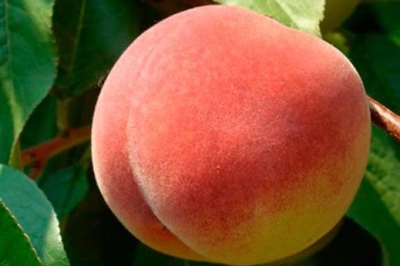
- Authors: Baltics
- Ripening period: early
- Self-fertility: self-fertile
- Appointment: for fresh consumption, for canning, for making juices
- Yield: fruitful
- Early maturity: in the 3rd year after planting
- Separability of the bone from the pulp: good
- Winter hardiness: high
- Disease and pest resistance: slightly exposed
- Fruit weight, g: 60-90
Peach is a popular horticultural crop with universal fruit. Although most varieties grow best in the southern regions, they are also found in the northern and central parts of the country. Juicy and tasty fruits are loved by adults and children.
Description of the variety
The Jelgavsky variety reaches an average height of 3.5 meters, but some specimens stretch up to 4 meters or more. The size of the crown is from 3 to 4 meters in diameter. The color of the petals is pink, uniform. Trees begin to bloom before they are covered with leaves. Their leaves are rich green, serrate at the edges.
Fruit characteristics
Medium-sized fruits gain in weight from 60 to 90 grams. The skin color is green-white. On the sunny side, a bright pink spot appears on the skin. There is a light flesh inside. It is tender in consistency and rich in juice. A large brown bone is formed in the fruit, which is easily detached from the pulp.
Taste qualities
The taste characteristics of the variety are excellent. The taste combines sweetness with pleasant sourness. Due to their high gastronomic qualities, peaches are often eaten in their natural form during the fruiting season. Also, the fruits are great for making jams, jam, candied fruits, juices and other fruit delicacies.
Ripening and fruiting
Trees will begin to bear crops only in the third year after planting. Fruits ripen early, in early August. Fruiting is regular.
Yield
The Jelgavsky variety is considered to be fruitful. With proper care and cultivation in comfortable conditions, the harvest will be regular and abundant. The branches are often overloaded with too much fruit. To avoid this, extra ovaries are removed.
Growing and care
Peach trees are demanding on agricultural technology. You need to plant trees only in areas with fertile and light soil. The acidity response should be low or neutral. Mineral compounds and organic fertilizers must be introduced into the ground so that young plants develop quickly and do not experience a lack of nutrition.
Peach belongs to vigorous fruit crops. On average, the growth reaches 60-80 centimeters and more. When using nitrogen fertilizers, they are applied in small portions so that the trees do not spend all their energy on the formation of deciduous mass.
For successful wintering, you will need formulations based on potassium and phosphorus. They are fed peaches in the fall during the digging of the site. Fertilizers are applied to the area of the trunk circle.
Optimum consumption per tree:
- organic - from 20 to 30 kilograms;
- superphosphate - 200-250 grams;
- potassium chloride - 100-120 grams;
- wood ash - 400 grams.
The nutrient solution is used 2 or 3 times throughout the growing season, with an interval of 3 to 4 weeks. For its preparation, the following components are used: rotted manure (in a ratio of 1x10), bird droppings (1x20), ammonium nitrate (from 2 to 3 tablespoons are consumed per 10 liters of water). 10 liters of the resulting composition are consumed per square meter of the site.
The first dose of fertilizer is applied in early April, and the second time the trees are fertilized in May.The third feeding is carried out at the beginning of June. You can slightly shift the deadline for the work, but no later than the beginning of July. Otherwise, the shoots will not stop growing at the right time and will freeze in winter.
When growing trees in dry soil 3-5 days before fertilization, the trees are watered abundantly, otherwise the roots can be burned. For young and short trees, the recommended fertilizer rate is reduced by 50%. The soil must be clean and moist. When weeds appear, they are immediately removed.
During watering, from 30 to 40 liters are consumed per adult tree, water consumption for young plants is 10-15 liters. Irrigation is carried out once a week. The Jelgavsky variety begins to bloom early and is covered with a large number of lush and bright flowers. If there are too many ovaries, they will deplete the tree, and the fruits will be small and lose their high taste.
Gardeners perform crop rationing, in the process of which they get rid of some of the ovaries. Small, weak and deformed ones are rejected. They will not yield a good harvest. There should be a gap of 15-20 centimeters between the remaining ovaries. If the branch is very short, only one full ovary is left.
Before the onset of winter, the trunks are covered with whitewash. To prepare a solution, a kilogram of lime, 100 grams of copper sulfate and a little clay are stirred in 5 liters of water so that the composition is viscous. Also protects the bases of skeletal shoots and stems. They are obliged with thick paper, burlap or spruce branches. The film will not work.
The root system is protected with mulch, which is laid on the surface of the soil. Needles, peat or sawdust are laid in a thick layer. If trees are effectively protected from the cold, they can survive frosts as low as 30 degrees below zero Celsius.
The sweet and vibrant peach fruit often attracts pests that attack other stone fruits as well. To protect the crop from them, they use ready-made compounds that can be found in any gardening store. They must be used strictly according to the scheme indicated on the package.
For rich and stable fruiting, the crown of the tree is regularly thinned out. It is also shaped for a neat appearance. Peach reacts remarkably to rejuvenating pruning.




































































